Cutting
Cutting Solutions: Your Complete Guide to Precision and Performance
Cutting applications are fundamental in the world of metal fabrication, industrial production, maintenance, repair, and operations (MRO). Cutting processes are the backbone of efficient workflows from slicing through sheet metal to removing excess material to prepare a part for the next stage of manufacturing. Achieving the perfect cut requires not only the right techniques but also the best abrasives for the job.
Choosing the right cutting wheels is critical for optimizing productivity, ensuring worker safety, and managing costs effectively. The wrong tool can lead to uneven cuts, wasted materials, and even hazardous situations in the workplace. With the proper cutting solutions, businesses can achieve precision, reduce downtime, and extend the lifespan of their equipment—all while staying competitive in their industries.
At Weiler Abrasives, we understand the challenges and demands of cutting applications. With decades of expertise and a deep commitment to innovation, we provide cutting wheels and solutions designed to meet the highest standards of performance and reliability. Our range of cutting products is engineered to deliver precision, speed, and durability, making Weiler a trusted partner for professionals across industries.
This guide explains the essentials of cutting applications and provides actionable strategies for finding the best cutting wheels for your needs.
The Fundamentals of Abrasive Cutting Wheels
Cutting with abrasive wheels is a versatile and precise process widely used in manufacturing, construction, and metalworking industries. This technique involves using abrasive materials to remove unwanted sections from a workpiece, producing clean and accurate cuts. It is essential for applications where traditional cutting wheels might struggle to achieve the desired precision or performance.
What are Abrasive Cutting Wheels Used For?
Abrasive cutting wheels are employed in a variety of applications. Common uses include:
- Cutting hard or heat-resistant metals such as stainless steel, titanium, and hardened alloys.
- Slicing through structural materials like rebar, pipes, and sheet metal.
- Precision cutting of components for engines, frames, and other critical parts.
Common Types of Abrasive Cutting Wheels
Abrasive cutting wheels are essential components in many industrial and fabrication processes, with each type tailored to specific applications and materials. Selecting the right cutting wheel is crucial for achieving precise, efficient, and safe cuts.
-
Type 1 Cutting Wheels
These wheels are flat, providing a large cutting area and enabling straight, clean cuts. They excel in cutting through solid materials like metal bars, sheets, and pipes. Their design makes them a versatile choice for various applications, especially in situations requiring precision.Type 27 Cutting Wheels
The depressed center of type 27 wheels allows for added clearance when the operator is working at a constrained angle. The profile of a depressed-center cutting wheel gives the operator a better view of the cut, and it provides the ability to flush-cut because the raised hub means the locking nut can be recessed.
Shop Our Extensive Line of Cutting Wheels
Cutting Wheel Structure
Cutting wheels typically consist of three primary components: the abrasive grains that perform the cutting, the bonds that hold the grains in place, and the fiberglass that reinforces the wheel. Each element plays a crucial role in the wheel's performance and durability, contributing to its efficiency across various applications.
GrainThe abrasive grains within the cutting wheel are responsible for the cutting action and are commonly made of Ceramic Alumina, Zirconia Alumina, Aluminum Oxide, or Silicon Carbide. The grit size of the abrasive grains also influences the cutting wheel's performance. Grit size refers to the size of the individual abrasive particles, ranging from 16 (coarse) to 60 (fine). Coarser grits cut more aggressively, while finer grits provide smoother cuts and more precision. Grains like Ceramic Alumina and Zirconia Alumina will self-sharpen as they wear down.
Bond
The bond of a cutting wheel holds the abrasive grains in place and determines the wheel's grade or hardness. The grade reflects the bond's hardness, not the grains themselves. A harder bond extends wheel life, while a softer bond wears faster but provides quicker cuts by exposing fresh grains.
For metals like stainless steel and aluminum, it's crucial to use contaminant-free abrasives (with less than 0.1% chlorine, iron, and sulfur) to avoid introducing impurities that can lead to rust. Contaminant-free products are labeled accordingly.
Resinoid bonds, made from organic compounds, are widely used for cutting wheels. They offer shock resistance and high-speed performance. Specialized resin-over-resin bonds enhance moisture and heat resistance, delivering a stronger bond and better grain utilization.
Fiberglass Reinforcement
Cutting wheels are reinforced with fiberglass, which can be single, double, or triple layered. A single layer of fiberglass is ideal for achieving exceptional cutting speed while minimizing burrs on the workpiece. Double and triple layers offer additional reinforcement, making them suitable for high-vibration and heavy-duty industrial applications. The additional reinforcement is essential to handle side load pressure that is inherent in manual cutting operations. This is especially important when larger wheels used on gas powered saws, stationary saws, and chop saws.
Industries and Applications for Cutting
Cutting operations are essential across a broad spectrum of industries. Here are a few key industries that require precise, efficient, and reliable cutting solutions.
- Metal Fabrication and Pipeline:
Accurate and fast cutting is crucial for preparing materials for welding and assembly in metal fabrication and pipeline work. Cutting wheels are ideal for slicing through sheet metal and structural components, ensuring clean cuts that reduce rework and increase productivity. - Automotive and Aerospace:
The automotive and aerospace industries demand precision cutting for components with tight tolerances. Cutting wheels are often used for applications such as trimming metal panels, cutting chassis components, and shaping aerospace alloys to support the production of high-quality vehicles and aircraft. - MRO (Maintenance, Repair, and Operations):
MRO professionals rely on cutting solutions for tasks such as removing worn-out components, resizing parts, and creating replacement sections. High-performance cutting wheels provide the reliability and performance needed to keep operations running smoothly. - Construction:
Cutting solutions are essential in construction for shaping materials like rebar, steel beams, and metal sheeting used in building frameworks and infrastructure. The right cutting wheels are built to handle tough conditions, delivering precise cuts on-site to help meet demanding project timelines. - Energy and Power Generation:
From wind turbine components to power plant infrastructure, the energy sector requires cutting wheels that can handle a variety of materials, including high-strength steel and composites. - Shipbuilding and Marine:
Shipbuilding involves cutting heavy-duty materials such as ship plates, bulkheads, and structural steel. Advanced cutting wheels are designed to perform in the challenging environments of shipyards, delivering clean, precise cuts that meet the rigorous standards of marine construction. - Railway Maintenance:
For railway maintenance, cutting wheels are typically large diameter used on gas powered saws. They’re essential for tasks like trimming rail sections, cutting bolts, and preparing components for repair or replacement. - Food and Pharmaceutical:
Stainless steel is a commonly used material for machinery and equipment in food processing and pharmaceutical manufacturing. Proper cutting wheels provide precise and cuts for creating or maintaining components, ensuring compliance with strict industry standards.
Challenges in Cutting Operations
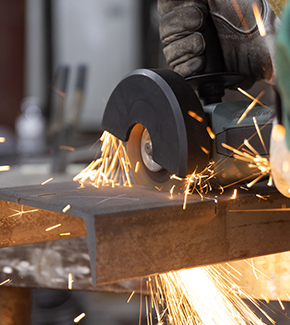
Material Wear and Tear on Wheels
Continuous cutting operations often lead to accelerated wear and tear on cutting wheels. Dull or worn wheels not only reduce cutting performance but can also result in increased operational costs due to frequent replacements and maintenance.
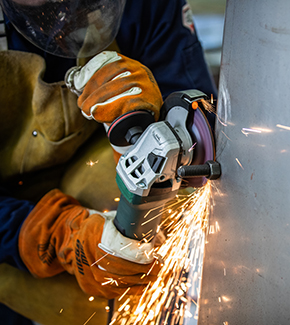
Downtime Due to Inefficient or Low-Quality Cutting Wheels
Inadequate cutting wheels or those not suited for specific materials can lead to unexpected downtime. Inefficiencies such as slow cutting speeds or wheel breakage disrupt workflows, delaying project timelines and increasing labor costs.
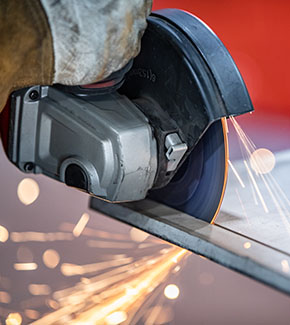
Safety Concerns
Improper wheel use and substandard products can pose significant risks. Using a cutting wheel for grinding or applying side pressure can lead to wheel failure, increasing the likelihood of injury. Additionally, not all cutting wheels meet the highest safety standards, making them more prone to breakage and wear. Choosing wheels that comply with ANSI, OSA, and EN standards, like those from Weiler Abrasives, helps ensure operator safety and long-term reliability in demanding applications.
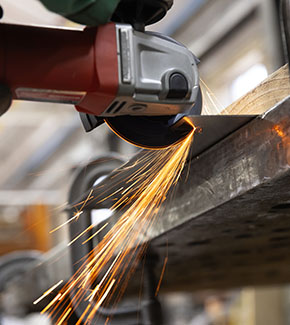
Achieving Precision in Complex Cuts
Precision cutting is essential in industries requiring intricate designs or exact specifications. Achieving this level of accuracy can be challenging, especially when dealing with hard-to-cut materials, tight tolerances, or complex geometries. Operators must balance speed with accuracy to get quality results without compromising productivity. A good general rule is to choose the thinnest cutting wheel that will make the cut and provide adequate life to find a balance of precision and performance..
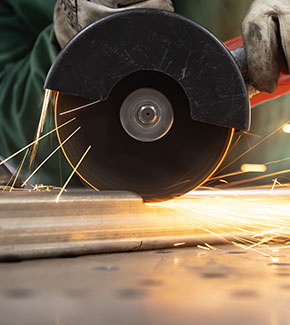
Having a Reliable Source for Ordering and Delivery
Timely access to cutting wheels and consumables is crucial to maintaining uninterrupted operations. Delays in ordering or unreliable suppliers can lead to downtime, impacting overall efficiency and customer satisfaction. Partnering with a dependable supplier ensures consistent access to high-quality wheels when and where they are needed.
Learn More About Cutting Challenges and Tips for Addressing Them
Choosing the Right Cutting Wheels for Your Project
When it comes to industrial cutting applications, selecting the right wheels can significantly impact efficiency, safety, and the quality of your work. The wide range of cutting wheels available makes it crucial to understand which options best align with your industry’s specific requirements. Here are some essential factors to consider.
Material Type
The type of material you’re cutting plays a pivotal role in wheel selection. Different materials require different cutting capabilities:
- Steel: Most bonded abrasive cutting wheels with aluminum oxide or zirconia alumina will perform well cutting steel and are ideal for handling steel, offering strength and heat resistance.
- Aluminum: Non-ferrous cutting wheels designed to minimize material sticking and provide smooth cuts are optimal for aluminum.
- Exotic Metals: Cutting exotic materials like titanium or Inconel demands advanced wheels with superior wear resistance. A cutting wheel with ceramic alumina is often a good choice for these metals.
Cutting Speed and Performance Requirements
Each industry has unique production goals that dictate cutting speed and performance priorities. Wheels with optimized cutting speeds ensure:
- Faster production cycles.
- Precise, clean cuts with minimal rework.
- Efficiency in high-volume operations. Selecting wheels designed for your desired cutting performance can enhance productivity and maintain consistency.
Cutting Wheel Thickness
The thickness of a cutting wheel plays a crucial role in achieving a precise, clean cut while balancing durability and material removal:
- Precision & Clean Cuts: Ultra-thin wheels, like our 1mm Ultracut wheel, provide the cleanest, most precise cuts with minimal burrs and material removal.
- Material Efficiency: Thinner wheels reduce material loss, which can lead to cost savings when working with expensive materials and improve part fit for better weld preparation.
- Durability Trade-Off: Thinner wheels wear down faster, so selecting the thinnest wheel that can effectively complete the job ensures both efficiency and longevity.
- Application Considerations: Thicker wheels remove more material and create larger burrs, which may require additional finishing steps. See our Bonded Guide for a visual comparison of wheel thickness in different applications.
Wheel Durability and Wear Resistance
Durable wheels reduce downtime and lower replacement costs, making them a critical consideration. Evaluate the following:
- Wheel composition: Choose wheels with self-sharpening grains and harder grade bonds for longer life.
Operator Safety and Ergonomics
Safety and ergonomics are paramount in any cutting application. The right wheels can mitigate risks and ensure operator comfort:
- Safety features: Wheels designed with minimal kickback and reduced heat generation help protect users from injuries.
- Ergonomics: Maintaining the proper angle of approach and applying the right amount of pressure reduces operator fatigue and maximizes cutting efficiency.
- Vibration: Vibration-resistant wheels reduce fatigue and improve operator precision over extended periods.
- Angle: Never use a cutting wheel for grinding, as side pressure can lead to wheel failure. Always operate cutting wheels at a 90-degree angle and check angle markings for safe, proper use.
Best Practices for Safe and Efficient Cutting
Safety Guidelines for Cutting Applications
Ensuring safety during cutting operations is paramount to protect operators and maintain optimal productivity. Follow these key safety guidelines:
Proper PPE (Personal Protective Equipment)
- Always wear ANSI-approved safety glasses or goggles to shield your eyes from flying debris.
- Use a face shield for additional protection, especially when working with larger cutting wheels or in high-speed applications.
- Wear cut-resistant gloves to protect your hands without compromising dexterity.
- Use hearing protection in noisy environments and respiratory protection when cutting materials that generate hazardous dust.
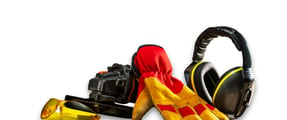
Tool Inspection and Maintenance Tips
- Inspect cutting wheels for cracks, chips, or other damage before use. A damaged wheel can shatter and pose serious safety risks.
- Confirm that the cutting wheel is rated for the tool's operating speed. Never exceed the maximum RPM marked on the wheel.
- Regularly check the tool’s guard and mounting flanges to verify they are secure and in good condition. Always use a guard designed for the power tool.
- Follow the manufacturer’s maintenance schedule for the tool to follow safe and reliable operation.
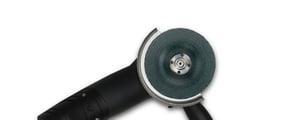
Operator Training Resources
- Ensure operators are trained on proper cutting techniques, including how to position the tool and control the wheel during use.
- Provide hands-on demonstrations to reinforce safe practices and troubleshooting skills.
- Share safety resources, such as videos, manuals, or onsite training programs, to keep safety top-of-mind.
Explore our S.P.O.T. Safety Program to see How we Can Help You Improve Cutting Wheel Safety
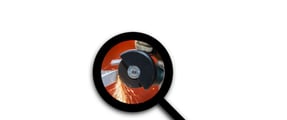
Efficiency Tips
In addition to safety, maximizing efficiency is essential for reducing costs and achieving optimal results. Here are some best practices for improving efficiency.
Maximizing Wheel Lifespan
- Use the right cutting wheel for the specific material and application to prevent premature wear.
- Avoid excessive pressure; let the wheel do the cutting to reduce wear and tear.
- Store wheels in a clean, dry environment to maintain their integrity and performance.
Techniques for Reducing Material Waste
- Mark cutting lines clearly and double-check measurements before starting to minimize mistakes.
- Select cutting wheels with precision-engineered edges for clean and accurate cuts.
- Optimize wheel usage by using the full cutting edge instead of overloading one section.
Optimizing Workflow with Weiler Abrasives
- Leverage Weiler’s innovative cutting wheels designed for high performance and durability, reducing the frequency of wheel changes.
- Choose products with features like reinforced fiberglass layers and precision-balanced designs to improve stability and reduce vibration.
- Utilize Weiler’s technical support team for advice on wheel selection and process improvements tailored to your applications.
Why Weiler for Cutting Solutions?
Innovation Driving Performance
Weiler prioritizes innovation not only in its products but also in its approach to solving process challenges. The Weiler Consumable Program (WCP) is a prime example, offering a blend of technical proficiency and practical insights to refine grinding operations. This program provides customers with structured strategies that focus on reducing costs while achieving higher quality standards.
Quality That Delivers Results
Weiler ensures quality through advanced manufacturing techniques and meticulous testing processes. Every grinding product is rigorously evaluated to meet or surpass industry standards for safety and performance. By prioritizing these measures, customers can achieve consistent production outcomes and improve operational efficiency.
Technical Support: Expertise When You Need It
Customers benefit from technical support that covers more than just product selection, with a focus on application-specific guidance. Process optimization services conducted on-site enhance the efficiency and value of deburring operations. Operator training sessions provide expertise in effective techniques and safety standards. Documentation support ensures seamless performance across all teams and operational shifts.
- New innovations help you meet environmental standards and sustainability expectations
- World-class research, development, and manufacturing capabilities keep your business ahead of the competition
- Proprietary technologies and global access to abrasive cutting wheels provide flexibility and freedom to develop limitless solutions
- Stable supply and local inventory to keep your business running smoothly and reduce your inventory burden
- On-site technical support and education to keep your cutting process optimized and your people safe
- Engineered solutions tailored to your specific applications
Our Customers Experience Unparalleled Results
“I just don’t want to be a gear supplier. I want to be a partner. And I think Weiler has done a good job of doing that with Rave.”
Duis aute irure dolor in reprehenderit in voluptate velit esse cillum dolore eu fugiat nulla pariatur. Reprehenderit in voluptate velit esse cillum dolore eu fugiat nulla pariatur.
Duis aute irure dolor in reprehenderit in voluptate velit esse cillum dolore eu fugiat nulla pariatur. Reprehenderit in voluptate velit esse cillum dolore eu fugiat nulla pariatur.
Related Resources
Weiler Abrasives offers a wealth of resources to support your cutting operations.
See how a manufacturer reduced downtime by 15% with Weiler Abrasives' Tiger Zirc cutting wheels.
A rail construction company achieved a 50% increase in product life, significantly reducing costs and improving project efficiency, with the support of Weiler Abrasives.
Through consolidation and expert guidance from Weiler Abrasives, an abrasives conversion company saved 15% on costs while improving efficiency.
Cutting Resources
Weiler Abrasives offers a wealth of resources to support your cutting operations.
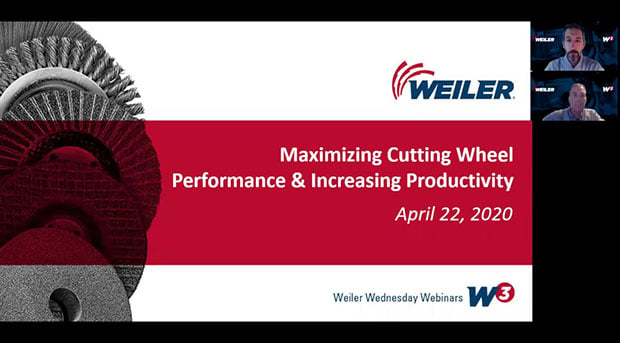
Webinar
Join Weiler Abrasives' webinar to explore expert strategies for maximizing abrasive performance, enhancing efficiency, and improving results in industrial applications.
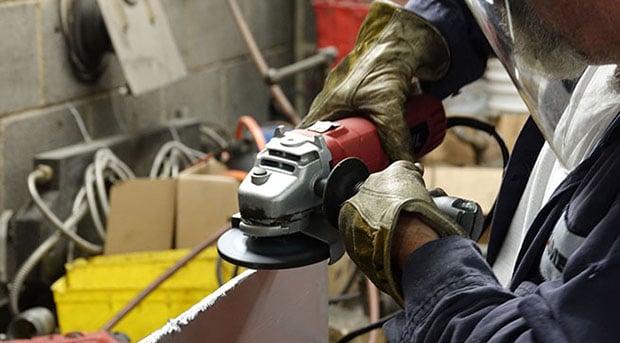
Guide
Get practical solutions for common issues with cutting wheels, grinding wheels, and flap discs in this comprehensive troubleshooting guide from Weiler Abrasives.
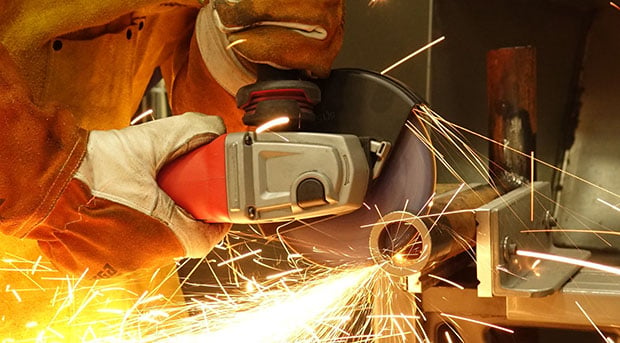
Article
Learn how to optimize abrasive performance for cutting and grinding tubes with expert tips and techniques from our experts.